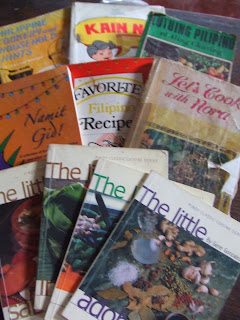In preparation for Advent, I was tasked by the Parish Scholarship Committee to give a 5-minute talk about sacrifice. My talk would be given to 70 scholars whose ages range from 7years old to 18 years old and a sprinkling of parents. Although I have never been comfortable speaking before a crowd, it was made doubly difficult as the talk had to be in Tagalog. The Committee felt that because of my difficulty with the language and my tendency to be goofy when nervous, the resulting talk would have some comedy element.
If I am to speak about sacrifice, then I too must walk the talk. Please allow me now to share with you the sacrifice I made by giving the short talk below (
and the sacrifice my listeners had to go through).. Comments on how else I could improve my tagalog is most welcomed. Who knows, there maybe a career for me as a stand-up comedian. Then again, this could be painful so you can just skip this part and scroll down for the recipe.
------------------------------------------------------------------
Sino sa inyo ay may gustong pumunta sa langit?
(A lot of hands were raised)Alam nyo ba kung paano makarating sa langit? (
you could hear a pin drop. Alam nyo pumunta sa Cubao o Makati pero hindi nyo alam paano pumunta sa langit…. finally some brave souls ventured to speak …magpakabait, masunurin sa batas ng bayan at simbahan— hindi magnakaw, mag simba, mag compisal, tumulong sa kawa, ,..etc…etc. )Kung tutuosin, madaling pumunta sa langit kung tularin natin si Jesus. Si Jesus ay suma cum laude sa pag-gawa ng sacripisyo para sa atin.
Madali talaga ang mag-sabi o isipin kung anong mga paraan para tularin natin si Jesus. Ang problema, mahirap gawin ang tama. Ang nakakalungkot pa, mas madali gumawa ang mali… hindi nakakapagod, hindi nakaka-abala sa atin, minsan nakakatuwa pa. Wag nalang pumasok sa paaralan—kapoy!
(smiles from the Visayans in the crowd) Wag nalang tumulong maglinis sa bahay— nakakadistorbo sa pag nood ng TV!
(guilty smiles from the kids) Mas masarap matulog kaysa pumunta sa simbahan. Mas-fresco kung sexy ang suot natin kung mag-simba tayo. Nakakatuwa mang-asar sa teacher o magulang
(lots of nodding of heads from parents).Pero nakita at narinig ko ang mga boses natin. Gusto natin pumunta sa langit. Pero kung talaga yon ang gusto natin, dapat simulan natin ang pag-sacripisyo o pag-alay ng mga mabuting gawain para kay Jesus ngayon na. As in NOW NA. Wag hintayin na mag-anonsyo si Kabayan Noli de Castro (news reporter) na may parating na malakas na bagyo. Wag hintayin na matapos ang away ni Pacman at Marquez. Wag hintayin na magka-pera tayo; wag hintahin ang birthday natin o retirement; wag hintayin ang bukas. Kasi, paano kung hindi dumating ang bukas. Porgatorio ang landing natin. O imperno—kung BIG Time ang mga kasalanan natin.
Ngayon, ito ang hamon ko sa inyo—sa atin lahat. Sa papel na ibibigay sa inyo ng mga mentors, i-sulat kung anong pwede nyo i-sacrifice or offer para kay Jesus. Hindi kaylangan BUNGA. Ang isulat nyo ay dapat kayang-kaya nyong gawin, kayang-kaya nyo i-promise ng gawing araw-araw. Isipin nyo na ang i-alay o sacripisyo nyo ay parang barya na iniipon sa isang alkansia. Sana, kung matapos ang buhay natin sa mundong ito—magkasakit, ma-aksidente, ma-kalamidad, tumanda-- puno na ang alkansia ng mga pang alay o sacripisyo at sapat gamitin para maka-pasok sa langit at umupo sa tabi ni Jesus.
Pagkatapos nyong isulat ang promise nyo, paki-bigay nalang sa mga mentors. Sa Christmas party natin, ibabalik ito sa inyo at i-alay ninyo ito sa sanggol na Jesus.
 (When I asked a Grade 1 scholar assigned to me what his sacrifice was, his exact response with matching naughty smile was, “Hindi na mag-cut ng clase.” That is enough for me. )
(When I asked a Grade 1 scholar assigned to me what his sacrifice was, his exact response with matching naughty smile was, “Hindi na mag-cut ng clase.” That is enough for me. )--------------------------------------------------
A feeding program takes place every Sunday at the same depressed area. Since our mentoring sessions only happens on the 2nd Sunday of each month, I sometimes get a chance to see what’s being served to the children ages 7 and below. The meal is very simple: chicken porridge, chicken adobo, boiled egg, chicken afritada or pancit in all its variation.
Interesting enough, a pancit that I saw being served at one Sunday was pancit miki (fresh egg noodle). Before I ever had sotanghon, bihon, or any other Asian noodles-- pancit miki was the first. I remember the plumpness, roundness, yellowness of the noodle and how my mother would purchase this fresh only at the wet market. Now-a-days, it’s a staple dish in many carenderia. So do give this lowly noodle a try when you need to get a noodle fix.
Mommy's Pancit Miki½ kilo fresh pancit miki (rinse in hot water to remove some of the saltiness)
Some oil for sauting
pork, sliced into strips- about ½ c
½ chicken breast, sliced into strips
100 grams shrimps, shelled, deveined and chopped coarsely
½ Chinese sausage, thinly sliced
1 small onion, sliced
1 clove garlic, sliced
About 1 cup of sliced cabbage
½ c carrot, sliced into strips
½ c sliced bagiou beans
1 ½ c stock or water
2 T soy sauce
Salt and pepper
1 t cornstarch dispersed in 1 T water (maybe omitted)
Heat oil and sauté the garlic, onions followed by the pork, chicken, shrimps and Chinese sausage. After a few minutes of stirring the ingredients around, pour in the stock or water. Bring to a boil then quickly lower heat so that mixture just simmers away. Add the soy sauce, salt and pepper. Cover and leave allow for about 5 minutes.
While continuing to simmer add the carrots and beans. After about 3 minutes, add the noodles and mix. Move the noddles to the side and add the cornstarch mixture. Stir in the remaining stock until it thickens. Add the cabbage and give the noodles a quick toss about. Check the seasoning and adjust as needed.
Serve while piping hot with a sauce of soy sauce & calamansi (lemon).

As there are a million ways with noodles, there are many ingredients you can add or omit:
-soften & sliced dried mushrooms
-cubes of fried tokwa (tofu)
- patola, peeled and cubed
- bell peppers
- ham
The sky’s the limit.














































